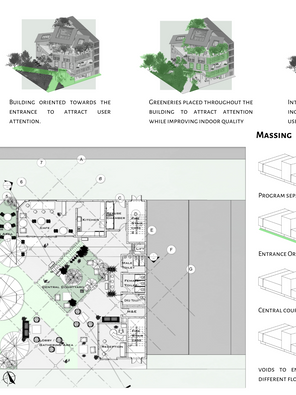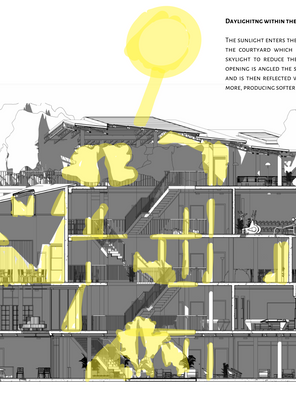Green Strategies Building Design
This module is an exploration of passive sustainable strategies in architectural design. It looks at the different elements that make up architecture and how the integration of passive design strategies with these elements contribute to the quality of spatial experience within a building. Student will undertake case studies to analyse the applications of these strategies and their impact on the quality and experience of space. The understanding of the various passive sustainable design strategies will inform the students’ own studio project.
Assignment 1: Passive Green Building Case Studies Poster & Booklet
This is a group assignment of 4-5 people where students are required to choose 2 case studies (preferably 3-5 Storey height) on the application of passive sustainable design strategies within an architectural project. The 2 case studies must contain 1 tropical climate and another from any other climatic region. Students are to identify and compare the passive design strategies applied in both case studies including factors of; site planning, daylighting, facade design, natural ventilation, and strategic landscaping. They are also to further analyze and elaborate on the impact of these passive design strategies on the quality and spatial experience of the chosen project. As an outcome, each group shall produce a 25-30 pages A4 landscape booklet and an A0 infographic poster along with a pre-recorded presentation of 10-15 minutes.
Assignment 2: Passive Green Building Strategies Report
This assignment is aligned with the Studio Design Project (semester 5) and aims to facilitate students in developing passive and active green building strategies simultaneously with their final architectural studio project. Students are expected to employ all passive green building strategies by their tropical building case study done in Assignment 1 wherever possible, including but not limited to site planning, daylighting, facade design, natural ventilation, strategic landscaping, and other renewable energies. The submission are expected to be compiled and documented in an A3 softcopy report in .pdf format.
Reflection
Throughout the course of this module, I learned how to utilize passive design strategies in my studio design. Passive design strategies are vital in sustainable architecture, utilizing natural resources and conditions to create energy-efficient and eco-friendly buildings. Their importance lies in the numerous benefits they offer. Firstly, passive design enhances energy efficiency by reducing reliance on mechanical systems, resulting in lower energy consumption and reduced carbon footprint. Secondly, these strategies promote environmental sustainability by optimizing renewable resources and minimizing the building's impact on the environment. Thirdly, the passive design prioritizes occupants' comfort and well-being by providing consistent indoor temperatures, natural lighting, and better indoor air quality. Overall, passive design plays a pivotal role in constructing sustainable, resilient, and environmentally responsible buildings for a better future.


















